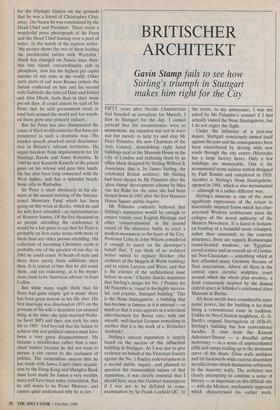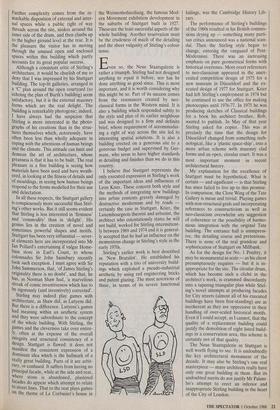BRITISCHER ARCHITEKT
Gavin Stamp fails to see how
Stirling's triumph in Stuttgart makes him right for the City
FIFTY years after Neville Chamberlain first boarded an aeroplane for Munich, I flew to Stuttgart for the day. I cannot pretend that the circumstances were so momentous: my intention was not to avert war but merely to help try and stop Mr Peter Palumbo, the new Chairman of the Arts Council, demolishing eight listed buildings next to the Mansion House in the City of London and replacing them by an office block designed by Stirling Wilford & Associates, that is, by James Stirling, the celebrated British architect. Mr Stirling had been chosen by Mr Palumbo after the `glass stump' development scheme by Mies van der Rohe for the same site had been turned down in 1985 after the first Mansion House Square public inquiry.
Mr Palumbo evidently believed that Stirling's reputation would be enough to ensure victory over English Heritage and other 'conservationists' in the second round of his obsessive battle to erect a modern monument in the heart of the City. Professor Colin St John Wilson considered it enough to assert on the developer's behalf that, 'I can think of no architect better suited to replace Belcher (the architect of the Mappin & Webb building) and to salute Lutyens and Wren; and that is the essence of the architectural issue before us now.' Charles Jencks maintains that Stirling's design for No. 1 Poultry for Mr Palumbo is, 'equal to his highly success- ful, and popular, Stuttgart building'. This is the Neue Staatsgalerie, a building that has become as famous as it is unusual — so much so that it even appears in a television advertisement for Rover cars, with one smooth, well-heeled German remarking to another that it is the work of a 'Britischer Architekt'.
Stirling's current reputation is largely based on the success of this influential building in Stuttgart. As I was due to give evidence on behalf of the Victorian Society against the No. 1 Poultry redevelopment in a second public inquiry, and planned to question the transcendent nature of that reputation, it was clearly essential that I should have seen this German masterpiece if I was not to be deflated in cross- examination by Sir Frank Layfield QC. In
the event, to my annoyance, I was not asked by Mr Palumbo's counsel if I had actually visited the Neue Staatsgalerie, but I do not regret the flight.
Under the influence of a post-war mayor, Stuttgart consciously turned itself against the past and the consequences have been exacerbated by driving wide new roads through the city centre (Mercedes has a large factory here). Only a few buildings are memorable. One is the monumental stone railway station designed by Paul Bonatz and completed in 1928. Another is Stirling's Neue Staatsgalerie, opened in 1984, which is also monumental — although in a rather different way.
Stirling's museum is one of the most significant expressions of the return to historically inspired forms which has char- acterised Western architecture since the collapse of the moral authority of the Modern Movement. It is faced in horizon- tal banding of a beautiful stone (clamped, rather than cemented, to the concrete structure), there are vaguely Romanesque round-headed windows, an 'Egyptian' coved cornice and an overall air of Germa- nic Neo-Classicism — something which at first offended many Germans because of Nazi associations. Above all there is the central open circular sculpture court around which the whole plan revolves, a form consciously inspired by the domed central space in Schinkel's celebrated Altes Museum in Berlin.
All these motifs have considerable emo- tional power, but the building is far from being a conventional essay in tradition. Unlike its Neo-Classical neighbour, G. G. Barth's original Staatsgalerie of 1838-43, Stirling's building has few conventional facades. It rises from the Konrad Adenauer-Strasse — a dreadful urban motorway — in a series of unprecedented cliffs and ramps leading up to the dominant curve of the drum. Glass walls undulate and tilt backwards while curious discordant metallic forms attach themselves arbitrarily to the masonry walls. The architect was clearly attempting to combine a sense of history — so important on this difficult site — with the Modern, mechanistic approach which characterised his earlier work. Further complexity comes from the re- markable disposition of external and inter- nal spaces while a public right of way threads across the site, snakes around the inner side of the drum, and then climbs up to the higher ground level at the rear. It is the pleasure the visitor has in moving through the unusual open and enclosed spaces within this building which partly accounts for its great popular success.
Although a consistent critic of Stirling's architecture, it would be churlish of me to deny that I was impressed by his Stuttgart building. The top-lit galleries, arranged in a 'C' plan around the open courtyard (so echoing the plan of Barth's building) seem satisfactory, but it is the external masonry forms which are the real delight. The building is remarkably photogenic; indeed, I have always had the suspicion that Stirling is more interested in the photo- graphs of his creations than in the struc- tures themselves which, notoriously, have often been less than wholly adequate in coping with the attentions of human beings and the climate. This attitude can limit and demean the art of architecture, whose greatness is that it has to be built. The real pleasure in a fine building is seeing how materials have been used and have weath- ered, in looking at the fitness of details and of mouldings, in seeing how human beings respond to the forms modelled for their use and delectation, In all these respects, the Stuttgart gallery is conspicuously more successful than Stirl- ing's other works. But it still seems evident that Stirling is less interested in 'firmness' and 'commodity' than in 'delight'. His genius lies in the creation of novel and sometimes powerful shapes and motifs. Stuttgart has been very influential — sever- al elements here are incorporated into Mr Ian Pollard's entertaining if vulgar Home- base store in Earl's Court, to whose colonnades Sir John Sainsbury recently took such exception. I must agree with Sir John Summerson, that, 'of James Stirling's originality there is no doubt', and that, he has, as Norman Shaw had, 'a marvellous streak of comic inventiveness which has to be rigorously (and inventively) corrected'.
Stirling may indeed play games with architecture, as Shaw did, as Lutyens did. But there is a difference. Lutyens's games had meaning within an aesthetic system and they were subordinate to the concept of the whole building. With Stirling, the games and the cleverness take over entire- often at the expense of the overall integrity and structural consistency of a design. Stuttgart is flawed: it does not manifest the consistent expression of a dominant idea which is the hallmark of a really great building. Parts of it are arbit- rary, or confused. It suffers from having no Principal facade, while at the side and rear, where stone is abandoned, plastered facades do appear which attempt to relate to street lines. That to the rear plays games on the theme of Le Corbusier's house in the Weissenhofsiedlung, the famous Mod- ern Movement exhibition development in the suburbs of Stuttgart built in 1927. These-are the least successful aspects of the whole building. Another reservation must be the crudeness of much of the detailing and the sheer vulgarity of Stirling's colour sense.
Even so, the Neue Staatsgalerie is rather a triumph. Stirling had not designed anything to equal it before, nor has he done anything as good since. This is most important, and it is worth considering why this might be so. Part of its success comes from the resonances created by neo- classical forms in the Western mind. It is also a building which responded subtly to the style and plan of its earlier neighbour and was designed to a firm and definite brief, whose requirement of accommodat- ing a right of way across the site led to interesting spatial solutions. It is also a building erected on a generous site to a generous budget and supervised by Ger- mans, who seem to have higher standards in detailing and finishes than we do in this country.
I believe that Stuttgart represents the only executed expression in Stirling's work of the important ideas and influences of Leon Krier. These concern both style and the methods of integrating new buildings into urban contexts gravely damaged by destructive modernism and by roads certainly the case in Stuttgart. Krier, the Luxembourgeois theorist and urbanist, the architect who ostentatiously states he will not build, worked for Stirling intermittent- ly between 1969 and 1974 and it is general- ly accepted that he had an influence on the momentous change in Stirling's style in the early 1970s. Stirling's earlier work is best described as 'New Brutalise. He established his reputation with a trio of university build- ings which exploited a pseudo-industrial aesthetic by using red engineering bricks and patent glazing. The most notorious of these, in terms of its severe functional failings, was the Cambridge History Lib- rary.
The performance of Stirling's buildings of the 1960s resulted in his British commis- sions drying up — something many parti- san critics announced was a national scan- dal. Then the Stirling style began to change, entering the vanguard of Post- Modernism. There was an increasing emphasis on pure geometrical forms with historical overtones. More overt references to neo-classicism appeared in the unex- ecuted competition design of 1975 for a new museum in Diisseldorf and the ex- ecuted design of 1977 for Stuttgart. Krier had left Stirling's employment in 1974 but he continued to use the office for making photocopies until 1976-77. In 1975 he was producing sketches of Classical buildings for a book his architect brother, Rob, wanted to publish. In May of that year Stirling asked for copies. This was at precisely the time that the design for Dusseldorf changed from something tech- nological, like a 'plastic space-ship', into a more urban scheme with masonry clad forms and an open, circular court. It was a most important moment in recent architectural history.
My explanation for the excellence of Stuttgart must be hypothetical. What is certain — and significant — is that Stirling has since failed to live up to this promise. In comparison, the Clore Wing of the Tate Gallery is mean and trivial. Playing games with non-structural grids and incorporating references to constructivism as well as neo-classicism overwhelm any suggestion of coherence or the possibility of harmo- nious integration with the original Tate building. The entrance hall is unimpress- ive, the detailing coarse and pretentious. There is none of the real grandeur and sophistication of Stuttgart on Millbank.
As for the design for No. 1 Poultry, it may be monumental in scale — as his client presumptuously requires — but it is in- appropriate for the site. The circular drum, which has become such a cliché in the architect's work, is crammed discordantly into a tapering triangular plan while Stirl- ing's novel attempts at producing facades for City streets (almost all of his executed buildings have been free-standing) are as incoherent as they are oppressive in their handling of over-scaled historical motifs. Even if I could accept, as I cannot, that the quality of a replacement building could justify the demolition of eight listed build- ings in a conservation area, this scheme is certainly not of that quality.
The Neue Staatsgalerie in Stuttgart is well worth flying to see. It is undoubtedly the key architectural monument of the decade. It may also be Stirling's one real masterpiece — many architects really have only one great building in them. But its undoubted merits do not justify Mr Palum- bo's attempt to erect an inferior and inappropriate Stirling building in the heart of the City of London.



































































 Previous page
Previous page